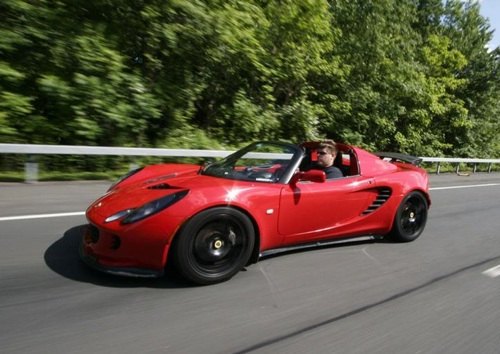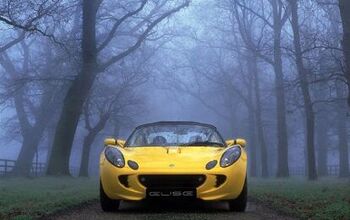Review: 2009 Lotus Elise

They say that “less is more” (whoever they are, and however much they weigh). The Lotus Elise is automotive proof of concept. Most of the Elises sold in the United Kingdom are 134-horsepower models powered by the same Toyota engine which, bolted to a base (in all senses of the word) Pontiac Vibe, permits America’s daytime strippers to make their late-morning commutes without mechanical incident. From what I’ve read, the base Elise is a stimulating, wonderfully balanced sporting car that permits man and machine to operate in perfect “B-road” harmony.
Here in the United States, however, we believe that “more is more.” So our base Elise has 189 horsepower, from the same Toyota engine which used to power the very fastest Pontiac Vibe. For those thrill seekers who want even more velocity, there’s the Elise SC, which has an amazing 217 horsepower to push just 1900 pounds. That gives you the power-to-weight ratio of a Camaro SS, you know, and you can buy one for just fifty-five grand.
Or, for those who want the true “more is a hell of a lot more” experience, PRI will rent you a turbocharged, Ohlins-shock-equipped, carbon-fiber-laden, 310-horsepower Elise for just under six hundred bucks per diem. When you ask them, “Where the hell should I drive this thing?” expect that they will recommend the twisting roads around New York’s Bear Mountain. Which is how I found myself heading directly at a hundred-foot dropoff into a lake at the kind of velocity that would permit a Boeing 747 to clear the runway, with only a low stone wall between myself and disaster.
The Elise driving experience is usually described as “go-kart-like” by jerkoff auto-journos who have never turned a single lap in a true racing kart. In reality, it’s nothing like a kart, because it has a suspension, doors and a distinct lack of imminent ribcage trauma. But it’s very much like what you expected from cars as a child. Seated in the surprisingly roomy cockpit, snuggled down between the boxy aluminum spars that make up the car’s frame, it’s difficult not to feel an immediate connection with the road. After all, your bottom is only about eighteen inches away from it.
The controls, from the little aluminum knobs which operate the auxiliary functions to the close-set pedals, operate with ball-bearing precision at all speeds. Steering feel is good but not perfect, surprisingly; although it’s a racing-style wheel, one has the feeling of rubber bushings between you and the tires, making it possible to occasionally dial in just a bit too much turn at higher speeds. As with the other PRI cars, there’s a complete audio system including a JL subwoofer strategically placed in the passenger footwell. It’s better to listen to the unearthly hiss of boost in each gear followed by the rude honk of the blow-off valve on corner entrance.
I’m running the Elise in convoy with a well-driven single-turbo Supra pushing out over 500 horsepower. Around Bear Mountain, I can toy with the Supra at will, carrying ten to fifteen miles per hour more into every turn and picking up throttle midcorner with insouciant ease, but I’d expected that. What I didn’t expect was the PCP-laced hit the turbocharger provides beyond 7000 rpm, and how little the big Supra could pull away on the straights. Even a blast down a straight four-lane couldn’t shake my little Lotus from the Toyota’s heels.
It’s frankly difficult to think of any faster dry-weather method for getting down twisty roads than this pressurized Radio Flyer. There’s enough power to spin the wheels in the dry almost everywhere, matched to the aforementioned Ohlins suspension to ensure maximum corner speed. I’d run this car against all comers on a road like the infamous “Tail of the Dragon”, for money, and I’d include motorcycles in that statement. The bikes couldn’t do enough on the straight to make up for the Elise’s superior broken-pavement grip.
Thirty miles of twisty roads into our test drive, I’m almost ready to forsake my long-held allegiance to Porsche, almost ready to forget the miserable experience I had owning a Lotus Seven clone back in 2002, almost ready to consider adding an Elise just like this one to my little fleet back home. And then we get on the freeway. Within minutes, my back has started to hurt, the blown Toyotamotor’s noise has changed from charming to oppressive, and the thrill of treating each pothole like a slalom cone at the SCCA Solo Nationals has become rather passé.
There’s a reason the Porsche Boxster outsells the Elise everywhere, even in the United Kingdom. The Lotus is a one-trick pony. The extra power, refinement, and conveniences added by PRI don’t change that one bit. Still, for those bright days and curvy back roads, there’s satisfaction to be found here like nowhere else.
[ Performance Rentals Incorporated provided the vehicle tested, insurance and gas.]

More by Jack Baruth
Latest Car Reviews
Read moreLatest Product Reviews
Read moreRecent Comments
- Bkojote Allright, actual person who knows trucks here, the article gets it a bit wrong.First off, the Maverick is not at all comparable to a Tacoma just because they're both Hybrids. Or lemme be blunt, the butch-est non-hybrid Maverick Tremor is suitable for 2/10 difficulty trails, a Trailhunter is for about 5/10 or maybe 6/10, just about the upper end of any stock vehicle you're buying from the factory. Aside from a Sasquatch Bronco or Rubicon Jeep Wrangler you're looking at something you're towing back if you want more capability (or perhaps something you /wish/ you were towing back.)Now, where the real world difference should play out is on the trail, where a lot of low speed crawling usually saps efficiency, especially when loaded to the gills. Real world MPG from a 4Runner is about 12-13mpg, So if this loaded-with-overlander-catalog Trailhunter is still pulling in the 20's - or even 18-19, that's a massive improvement.
- Lou_BC "That’s expensive for a midsize pickup" All of the "offroad" midsize trucks fall in that 65k USD range. The ZR2 is probably the cheapest ( without Bison option).
- Lou_BC There are a few in my town. They come out on sunny days. I'd rather spend $29k on a square body Chevy
- Lou_BC I had a 2010 Ford F150 and 2010 Toyota Sienna. The F150 went through 3 sets of brakes and Sienna 2 sets. Similar mileage and 10 year span.4 sets tires on F150. Truck needed a set of rear shocks and front axle seals. The solenoid in the T-case was replaced under warranty. I replaced a "blend door motor" on heater. Sienna needed a water pump and heater blower both on warranty. One TSB then recall on spare tire cable. Has a limp mode due to an engine sensor failure. At 11 years old I had to replace clutch pack in rear diff F150. My ZR2 diesel at 55,000 km. Needs new tires. Duratrac's worn and chewed up. Needed front end alignment (1st time ever on any truck I've owned).Rear brakes worn out. Left pads were to metal. Chevy rear brakes don't like offroad. Weird "inside out" dents in a few spots rear fenders. Typically GM can't really build an offroad truck issue. They won't warranty. Has fender-well liners. Tore off one rear shock protector. Was cheaper to order from GM warehouse through parts supplier than through Chevy dealer. Lots of squeaks and rattles. Infotainment has crashed a few times. Seat heater modual was on recall. One of those post sale retrofit.Local dealer is horrific. If my son can't service or repair it, I'll drive 120 km to the next town. 1st and last Chevy. Love the drivetrain and suspension. Fit and finish mediocre. Dealer sucks.
- MaintenanceCosts You expect everything on Amazon and eBay to be fake, but it's a shame to see fake stuff on Summit Racing. Glad they pulled it.




































Comments
Join the conversation
I love this car. I had a chance to drive one around the Monterey Penninsula about three of years ago and really couldn't stop smiling. It was the first U.S. spec model with 189 hp. I found it surprisingly comfortable but then I never had the top on it. The reflective "dots" on the freeway felt like speed bumps at speed, though. There are some reasons why eBay always seems full of low-mileage Elises, though. Either they got their miles on the track and are beat to hell or, more likely, someone bought them and decided (or their better half decided) that the compromises were too great. The general non-car-loving public really don't get sports cars. I have a 1991 Miata which is pretty spartan compared to current cars but feels like a Cadillac relative to the Elise. I used it for a daily driver for years and made a couple of cross-country trips. Yet I get a lot of comments from people about how one can live with such a tiny car and how unsafe they are. I just ask them why they need to haul around three empty seats and an empty moving crate just to get to work by themselves?
I have always thought I wanted an Elise, but I have a racing kart and a track nearby, so... I wonder, how much not like my kart is this car?